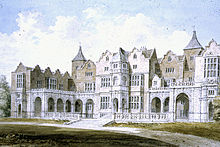- Holland House, London
-
Coordinates: 51°30′9″N 0°12′9″W / 51.5025°N 0.2025°W
Holland House, originally known as Cope Castle, was one of the first great houses built in Kensington in London, and is situated in Holland Park.
Contents
Origins, in the Civil War, and beyond
Holland House was built in 1605 for Sir Walter Cope. It presided over a 500 acres (200 ha; 0.78 sq mi) estate that stretched from Holland Park Avenue to the current site of Earl's Court tube station, and contained exotic trees imported by John Tradescant the Younger.[1] Following its completion, Cope entertained the king and queen at it numerous times; in 1608, John Chamberlain, the noted author of letters, complained that he was "not allowed to touch even a cherry because the queen was expected".
Following the death of King James I's son Henry Frederick, Prince of Wales in November 1612, he spent the night at Cope Castle, being joined the following day by his son Prince Charles and granddaughter Princess Elizabeth, and Frederick V, Elector Palatine.
Cope's son-in-law, Henry Rich, 1st Earl of Holland eventually inherited the house. He was later beheaded for his Royalist activities during the Civil War and the house was then used as an army headquarters, being regularly visited by Oliver Cromwell. After the war, it was owned by various members of the family and renamed Holland House. In 1719, Joseph Addison, the English essayist, poet and politician, died in the building.
Holland House passed to the Edwardes family in 1721. Henry Fox, 1st Baron Holland died at Holland House in 1774 and thereafter it was inherited by his descendants until the title became extinct with the death of Henry Edward Fox, 4th Baron Holland in 1859; however, his widow continued to live there for many years, gradually selling off outlying parts of the park for development. In 1874, the estate passed to a distant Fox cousin, Henry Fox-Strangways, 5th Earl of Ilchester.
As 19th century social centre
Under the 3rd Lord Holland and his wife, Lady Holland, the house became noted as a glittering social, literary and political centre with many celebrated visitors such as Byron, Thomas Macaulay, the poets Thomas Campbell and Samuel Rogers, 'Conversation' Sharp, Benjamin Disraeli, Charles Dickens and Sir Walter Scott.The figure of the political and historical writer John Allen was so associated with the house that he was known as Holland House Allen and there is a room in the house named after him.[2]
Harper's New Monthly Magazine described Holland House as having had a "Gilt Chamber", where "the figures over the fireplace were painted in flesh colour wherever bare; the rest was in shaded gold. The lower marbles of the fireplace were black, and the upper ones were Sienna; the capitals and bases of the columns and pilasters were gilt, and the groundwork from which all the glittering decoration rose was white."[3]
The house's dower house, known as Little Holland House, became the centre of a Victorian artistic salon presided over by the Prinseps and the painter George Frederic Watts.
20th century and wartime destruction
Queen Elizabeth, The Queen Mother and King George VI attended the last great ball held at the house a few weeks before the outbreak of World War II. In September 1940, the building was badly hit during a ten hour bombing raid and largely destroyed. It passed into the ownership, with its grounds, of the local authority. Today the remains form a backdrop for the open air Holland Park Theatre, home of Opera Holland Park. The YHA (England and Wales) "London Holland Park" youth hostel is now located in the house. The Orangery is now an exhibition and function space, with the adjoining former Summer Ballroom, The Belvedere, now a restaurant. The former Icehouse is now a gallery space. The grounds provide sporting facilities, including a cricket pitch/football oval and 6 tennis courts.
References
- ^ Elizabeth Allen (2004-09). "Cope, Sir Walter (1553?–1614)". Oxford Dictionary of National Biography. Oxford University Press. doi:10.1093/ref:odnb/6257. http://www.oxforddnb.com/view/article/6257. Retrieved 2009-06-01.
- ^ Brian Harrison (ed), (2004), Oxford Dictionary of National Biography, page 309, (Oxford University Press)
- ^ "Elizabethan and later English furniture". Harper's New Monthly Magazine 56 (331): 23–24. 1877-12.
External links
Categories:- Grade I listed buildings in London
- Grade I listed houses
- Youth hostels
- Former castles
- Buildings destroyed during World War II in the United Kingdom
- Buildings and structures completed in 1605
- Former houses of Kensington and Chelsea
- Fox family (English aristocracy)
Wikimedia Foundation. 2010.




